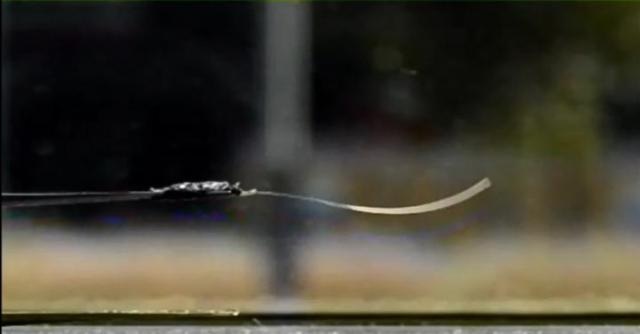Jul 6 2016
A team of researchers from Eindhoven University of Technology (TU/e) and Humboldt University in Berlin showcased a thin layer of plastic material in the Nature Communications journal, which has the capacity to move spontaneously under the influence of daylight. The researchers feel that this flexible plastic is appropriate as a self-cleaning surface, for example it can be used in solar cells.
 Why the plastic begins to oscillate spontaneously is something that the researchers cannot yet quite explain. (Credit: Eindhoven University of Technology)
Why the plastic begins to oscillate spontaneously is something that the researchers cannot yet quite explain. (Credit: Eindhoven University of Technology)
The process in which materials move entirely by themselves under the impact of light is a familiar process known for many years. However, the required intensity of ultraviolet light can damage the material.
Discovering a material that has the ability to behave in the same way even under the influence of visible light such as unprocessed sunlight was the challenge.
The researchers have successfully manufactured a thin polymer layer that contains light-sensitive molecules referred to as azo-dyes. The thin film starts to oscillate immediately and spontaneously when exposed to sunlight.
This is a movie of the self-oscillating plastic when placed in sunlight. (CREDIT: TU EINDHOVEN)
Combination of factors
The researchers are not yet able to explain the plastic's behavior.
It seems to be a combination of factors. The light-sensitive molecules bend and stretch under the influence of visible light. Since these molecules are bound within the polymer network of crystal, this results in the material oscillating as if cramped. Of course, there’s more to it than that – this is what we are investigating now.
TU/e researcher Michael Debije
Self-cleaning
The material can be considered for use as a self-cleaning surface.
A surface that vibrates in the sun makes it difficult for sand and dust to stick to it.
Debije
Fellow researcher, Dick Broer, feels that solar panels that are capable of self-cleaning are suitable for desert areas where there is no water supply. However, the researchers believe that there are various other possible applications.
We have just discovered the effect; we expect that this will attract attention from many researchers from whom we will be hearing a lot over the coming period.
Debije